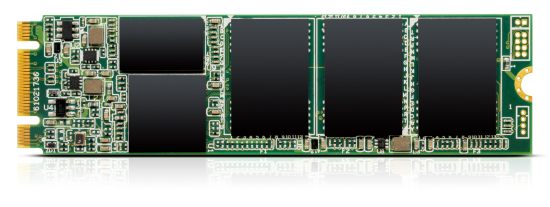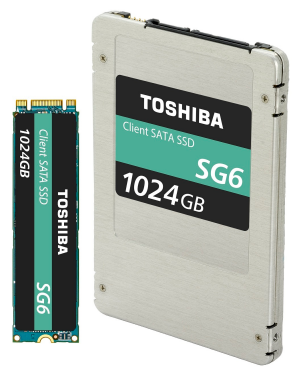- Details
- Network Storage
Synology Inc. today launched the new DiskStation DS418j, a budget-friendly 4-bay NAS server designed to help home and individual users to manage, protect and share data effectively.

DS418j is powered by a brand-new 64-bit dual-core CPU and delivers an outstanding encrypted file transfer performance at over 112 MB/s reading and 87 MB/s writing under a RAID 5 configuration in a Windows® environment. Equipped with a 1GB DDR4 memory, which is twice the size of its predecessor, and over 40TB single volume raw capacity support, DS418j brings flexible storage management in addition to smooth performance.
0 Comments- Details
- Flash Memory
CORSAIR, a world leader in enthusiast memory, high-performance gaming hardware, and PC components, today announced the launch of the CORSAIR Neutron NX500 NVMe PCIe SSD AIC. The NX500 boasts performance up to five times faster than traditional SATA 3.0 SSDs, connecting to your system via an available PCI Express 3.0 x4 slot. Achieving up to 3,000MB/sec sequential read and 2,400 MB/sec sequential write speeds, or 300K/270K IOPS random read/write, the NX500 is the fastest SSD CORSAIR has ever produced.

Available in 400GB, 800GB and 1,600GB capacities, and clad in a custom-designed high-surface-area heat sink, the NX500 is engineered for speed and all-but eliminates performance thermal throttling thanks to temperatures up to 20°C lower than m.2 PCI Express NVMe SSDs. Whether you’re editing video, transferring files or loading the latest games, the NX500 has the cooling, style and performance and to make sure both you and your system never fall behind.
0 Comments- Details
- Flash Memory
ADATA Technology, a leading manufacturer of high performance DRAM modules and NAND Flash products, today launched the industrial-grade IM2S3338 M.2 2280 and IM2S3334 M.2 2242 SATA 6Gbps solid state drives. Both utilize the compact M.2 form factor for an easy fit in various installations and transfer data at up to 560MB/s read and 525MB/s write. They use durable and long-lasting 3D NAND, MLC/TLC for the IM2S3334 and TLC on the IM2S3338. The two drives are carefully tested for survivability in extreme temperatures and humidity as well as resistance to shocks and vibration. ADATA integrates LDPC error correction to promote data integrity plus DRAM and SLC caching to help sustain peak performance on both model ranges.

Ever-expanding industrial storage portfolio
ADATA continues to place an emphasis on serving industrial and commercial applications such as manufacturing, surveillance, retail, transportation, and medical care. The IM2S3338 and IM2S3334 provide additional options, this time in the M.2 form factor. The IM2S3338 uses 3D TLC in capacities from 128GB to 1TB. It delivers 560MB/s read and 520MB/s write. The IM2S3334 carries highly durable 3D MLC NAND in 120GB to 512GB, and 3D TLC in 128GB to 512GB, and runs at up to 560MB/s read and 525MB/s write. Users therefore get a comprehensive range of models to choose from based on required capacity and planned budget.
- Details
- Flash Memory
Silicon Motion Technology Corporation ("Silicon Motion"), a global leader in designing and marketing NAND flash controllers for solid-state storage devices, today announced the availability of the industry's broadest portfolio of merchant turnkey SSD (solid state disk) controller solutions, including the new ultra-high speed SM2262EN and SM2262 for client, the SM2263 for mainstream and the SM2263XT DRAM-less controller, which supports the BGA form factor.
With the new SM2262 and SM2263 series, Silicon Motion provides PCIe G3 x 4 Lanes NVMe 1.3 controllers while supporting the latest 3D NAND from the main flash manufacturers. The SM2262EN, an ultra-high performance SSD controller solution, delivers peak sequential read and write transfer speeds of up to 3,500 MB/s and 3,000 MB/s, respectively, and random read and write IOPS of up to 370,000 and 300,000. The SM2263 is targeted at mainstream client applications and features sequential read and write speeds of up to 2,400 MB/s and 1,700 MB/s respectively. The SM2263XT, a DRAM-less controller solution, reduces BOM cost and form factor without compromising performance while enabling 11.5mmx13mm BGA SSDs ideally suited for 2-in-1 systems, chromebooks and mobile devices.
0 Comments- Details
- News
 Kingston Digital, Inc., the Flash memory affiliate of Kingston Technology Company, Inc., the independent world leader in memory products, today announced over 6 million SSD units between the Kingston and HyperX lines have shipped worldwide featuring Marvell controllers. The feat was accomplished in just over two years as the HyperX Predator PCIe SSD in February 2015 was the company’s first SSD to ship utilizing a Marvell controller. Marvell’s 88SS9293 controller provides lightning fast, next generation SSD performance making HyperX Predator PCIe SSD a must have for system-builders and enthusiasts.
Kingston Digital, Inc., the Flash memory affiliate of Kingston Technology Company, Inc., the independent world leader in memory products, today announced over 6 million SSD units between the Kingston and HyperX lines have shipped worldwide featuring Marvell controllers. The feat was accomplished in just over two years as the HyperX Predator PCIe SSD in February 2015 was the company’s first SSD to ship utilizing a Marvell controller. Marvell’s 88SS9293 controller provides lightning fast, next generation SSD performance making HyperX Predator PCIe SSD a must have for system-builders and enthusiasts.
Wanting to offer users of all levels the benefits of high performance from an SSD, Kingston released UV400, powered by Marvell’s 88SS1074 four-channel controller in May of 2016. As the product family evolves later this year, Kingston will launch the UV500 series, its first 3D NAND-enabled SSD utilizing Marvell’s newest 88SS1074 full turnkey (FTK) solution. UV500 will be available in 2.5″, M.2 and mSATA form factors providing solutions for any consumer and system builder SSD needs. It is designed for mainstream client use but also has 256-bit AES encryption and TCG Opal 2.0 enabled for enterprise users as well.
“Marvell is proud of the success in our collaboration with Kingston, and is excited to be extending it with our first in-house developed FTK solution on our 88SS1074 controller,” said Nigel Alvares, VP of SSD & Enterprise Storage Marketing, Storage Group, Marvell. “Kingston’s UV500 will be able to offer industry-leading 3D NAND performance, endurance, data integrity and reliability using our third generation of NANDEdge™ technology, the industry’s most advanced low-density parity check (LDPC) error correction platform available, and integrated in all of our latest SATA, SAS and PCIe controllers.”
- Details
- Flash Memory
Seagate Technology plc announced today at the 2017 Flash Memory Summit (FMS) enhanced versions of two flash technologies to boost performance and capacity for mixed data center workloads. The updated solid-state drives — including the Nytro® 5000 M.2 non-volatile memory express (NVMe) SSD and the Nytro 3000 Serial Attached SCSI (SAS) SSD — address different segments of the cloud and data center markets and help organizations maximize the value of their data. Anticipating the needs of a range of hyperscale data centers and cloud providers in the future, Seagate also will highlight a 64-terabyte (TB) NVMe add-in card (AIC) reading 13 gigabytes per second (GB/s) — the fastest and highest-capacity SSD ever demonstrated.
As next-generation versions of the Seagate Nytro XM1440 M.2 NVMe SSD and the Seagate 1200.2 SAS SSD, respectively, the Nytro 5000 NVMe M.2 SSD and Nytro 3000 SAS SSD offer new levels of performance and scalability. The Nytro 5000 NVMe M.2 SSD is a cost-effective, lower-power technology ideal for the demands of today’s data center environments with 2TB of industry-leading capacity. It also boosts random write performance levels as high as 67,000 input/output operations per second (IOPS) — double the performance levels of the previous version. The SSD’s new features match the growing needs of demanding enterprise applications like data mining, weather modeling and online transaction processing, where fast data access and processing power are paramount to an organization’s success. The SSD also comes with configurable overprovisioning, providing additional layers of flexibility so organizations can adjust the drive’s endurance and capacity properties based on their specific data storage needs — all in a small footprint to allow data centers to more easily scale and accommodate exponential data growth.
0 Comments- Details
- Flash Memory
Kingston Digital, Inc., the Flash memory affiliate of Kingston Technology Company, Inc., the independent world leader in memory products, today announced it will demo the forthcoming DCU1000 2.5″ U.2 NVMe PCIe SSD at Flash Memory Summit 2017 (FMS Booth #827). DCU1000 makes Kingston® one of the industry’s most complete providers of end-to-end data performance solutions — from leading server memory products to its highest performance NVMe SSD solutions.
During FMS, Kingston and its partners will provide a variety of demonstrations highlighting the performance capabilities of DCU1000, the industry’s fastest NVMe SSD for the U.2 form factor. Kingston will demonstrate multiple DCU1000 configurations including multi-million IOPS from a single server solution; a composable infrastructure solution leveraging DCU1000; and, a video wall featuring hundreds of videos streaming from a single Kingston NVMe PCIe SSD.
“With the introduction of DCU1000, we are proud that Kingston has developed the industry’s most complete family of data performance solutions inside the box that address low-latency throughput requirements across the entire data pipeline,” said Ariel Perez, SSD business manager, Kingston. “From server memory modules to the latest SATA and PCIe NVMe SSDs, we can satisfy the data and server storage performance needs from workstations to any size data center, Cloud computing and hyperscale environments.”
0 Comments- Details
- Flash Memory
Samsung Electronics, the world leader in advanced memory technology, has announced new V-NAND (Vertical NAND) memory solutions and technology that will address the pressing requirements of next-generation data processing and storage systems. With the rapid increase of data-intensive applications across many industries using artificial intelligence and Internet of Things (IoT) technologies, the role of flash memory has become extremely critical in accelerating the speed at which information can be extracted for real-time analysis.

At the inaugural Samsung Tech Day and this year’s Flash Memory Summit, Samsung is showcasing solutions to address next-generation data processing challenges centered around the company’s latest V-NAND technology and an array of solid state drives (SSDs). These solutions will be at the forefront of enabling today’s most data-intensive tasks such as high-performance computing, machine learning, real-time analytics and parallel computing.
0 Comments- Details
- Flash Memory
Micron Technology, Inc.today introduced Micron 9200 Series of NVMe™ SSDs, the company's latest flagship performance solid-state storage family. The innovative architecture and industry leading performance of Micron 9200 SSDs allows organizations to access data faster and stay one step ahead of the growing diversity of business-critical workloads and surging data demands.

The new Micron 9200 SSD combines the cost-effective capacity of 3D NAND with the proven throughput and response time of the NVM Express (NVMe) protocol. Built from the ground up to remove legacy layers of hard drive interfaces, Micron's second generation of NVMe drives unleashes the speed of solid state nonvolatile memory to maximize data center efficiency for optimal total cost of ownership (TCO).
0 Comments- Details
- Flash Memory
Toshiba America Electronic Components, Inc. (TAEC), a committed technology leader, announces the new SG6 series, the latest Toshiba client SSD to feature 64-layer, 3-bit-per-cell TLC (triple-level cell) BiCS FLASH™ to deliver better transfer speeds and power efficiency. This family of SSDs is designed for mainstream desktops and notebooks, consumer upgrades, as well as applications needing data security.

With increased performance over the prior generation, SG6 features the latest SATA technology to deliver up to 550 MB/s sequential read and 535 MB/s sequential write, and up to 100,000 and 85,000 random read/write IOPS delivering enhanced application performance. Furthermore, compared to its previous generation, active power consumption was decreased by up to 40% enabling increased battery life for mobile computing.
0 Comments
